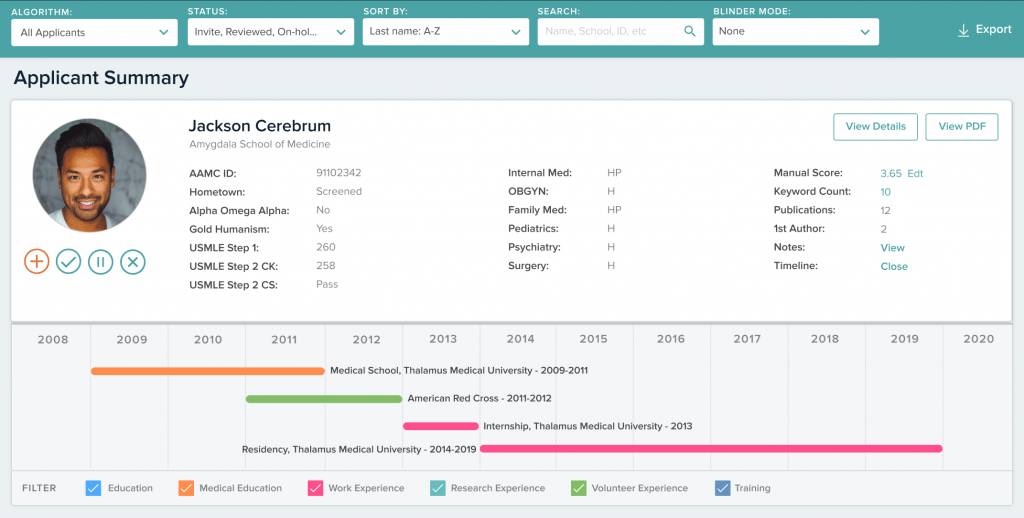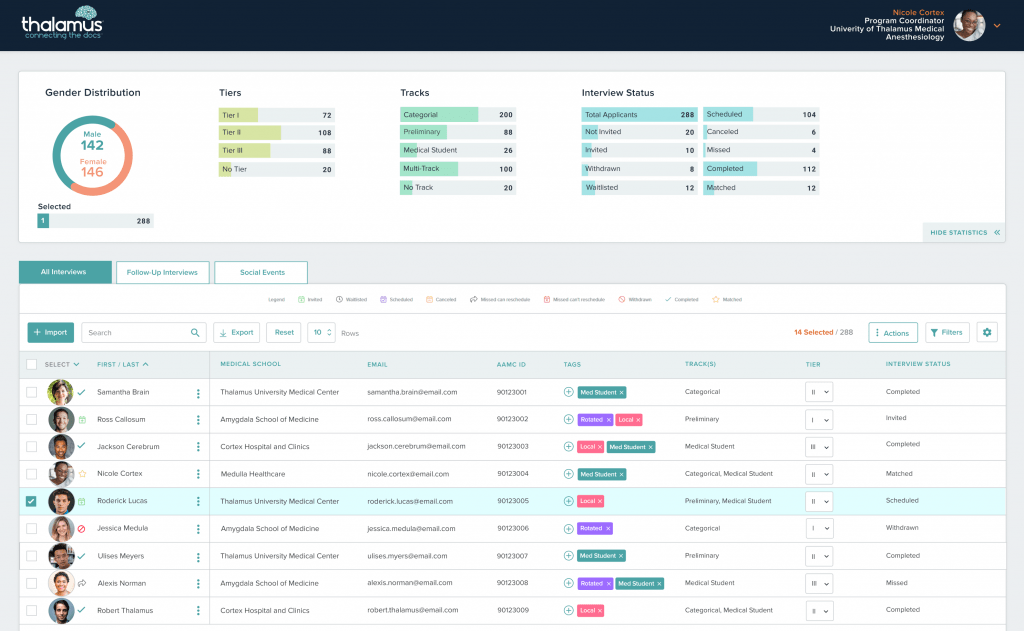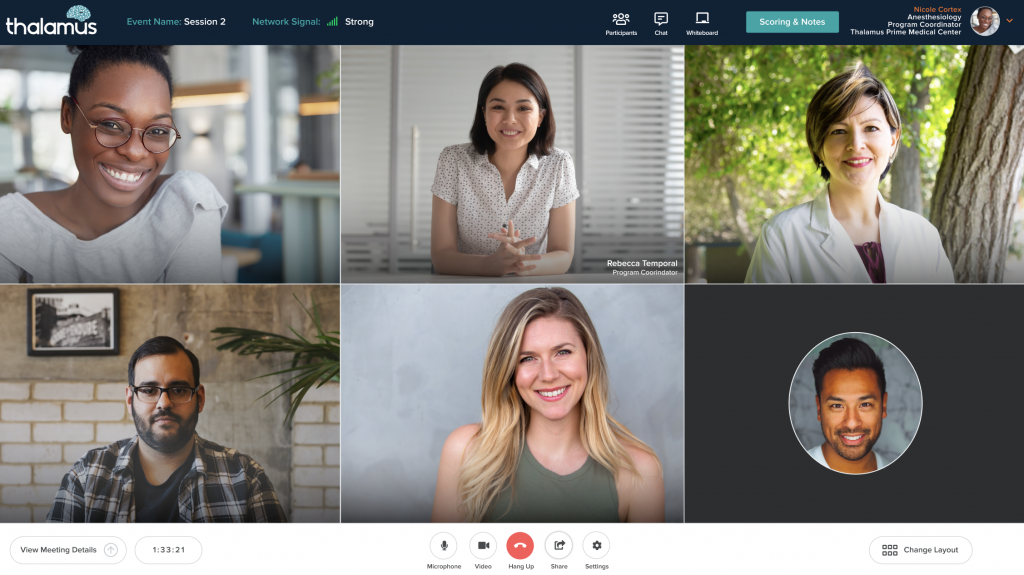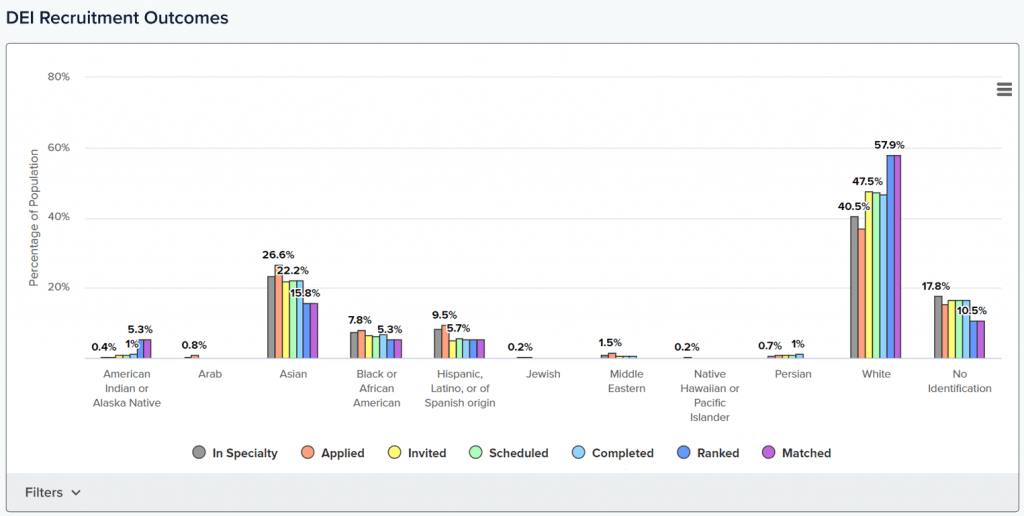In the past years, we have seen an increased and needed awareness regarding the challenge of building a more diverse, equitable, and inclusive (DEI) environment in both graduate medical education (GME) recruitment and healthcare at-large. DEI in healthcare is invaluable to all patients and providers. This is especially true in communities that are underserved and underrepresented in healthcare. Several groundbreaking research initiatives have shown that representative care is critical to improved outcomes, especially in these patient populations, including in the Journal of the American Medical Association. Overall, patient populations are better understood, respected, valued, and advocated for by their healthcare team by increasing diverse representation in the healthcare workforce.
This further translates upstream to GME training programs, which serve as the gateway to the US physician workforce. While GME stakeholders continue to innovate including an abrupt shift to virtual interviews due to the COVID-19 pandemic or tackling long-established challenges involving application inflation and over-invitation for interviews, there is a growing passion to create a process that is more DEI-focused. And for Team Thalamus, we believe that technology can assist in making this hopeful future a reality. So the focus of this week’s blog is to illustrate how Thalamus innovates through technology to increase diversity, equity, and inclusion in residency and fellowship recruitment.
Where are we now?
Current estimates by the American Association of Medical Colleges (AAMC) predict an impending physician shortage of 37,800 to 124,000 by 2034. This shortage is expected to effect both underserved and underrepresented patient populations most significantly. To address these challenges, it is critical that residency and fellowship program recruitment strategies within GME are aligned in creating a physician workforce that is representative of the diverse patient population it serves.
Historically, the tools available for recruiting GME positions have relied on self-identification data that requires significant manual processing and analysis by institutional/program coordinators/administrators, and is limited in its standardization and inclusivity. Further, there are current limitations to the methods by which self-identified ethnicity data is collected through applications and other systems. Several GME stakeholders use six major categories for ethnic identification including “American Indian or Alaska Native”; “Asian”; “Black or African American”; “Hispanic, Latino or of Spanish Origin”; “Native Hawaiian or Pacific Islander”; and “White.” Sub-categories then allow for further and more specific identification, although often varies by data collector as well.
It is this variance across organizations and institutions that has made data aggregation challenging. This includes both the breadth and depth of sub-population classifications. Further, much of the reporting to date is done through time-consuming and manual data collection work, including spreadsheets and report building. These activities require data aggregation and clean up across not only individual residency and fellowship programs, but across entire institutional (and regional/national) GMEs, where certain specialties not only cross recruitment seasons, but also entire academic years. This leads to issues with data standardization, exacerbating challenges of data reliability and actionable outcomes.
Further, the process also currently bypasses much of the diversity seen in UME and GME trainee populations, specifically 1) those not identifying with any major category and 2) those identifying with more than one of the major categories (i.e. across categories).
As an example, for the 2021-2022 application residency recruitment season:
- 23% of applicants list no identification on their application.
- 77% of applicants identified with one or more major categories.
- 8% of applicants identified with two or more major categories.
- 1% of applicants identified with three or more major categories.
There are also limitations on identifying data for sex and/or gender. Historically, candidates have been able to select male, female, or decline to answer (with a potential inclusion of “other” as part of a recent community announcement). Thus, there continues to be a significant gap regarding the broader inclusion of the LGBTQIA+ community, and furthering the “othering” that has been associated with this portion of the applicant pool.
This has significant downstream effects on the LGBTQIA+ community, another underserved patient population in healthcare today. Applicants associating with and/or possessing clinical interest in the field/patient population, must then either explicitly state this in their application experiences section or personal statement. Conversely, there may also be attempts to hide this aspect of themselves concerned with potential negative stigma. Similarly, residency programs with underserved LGBTQIA+ patient populations often have to “read between the lines” to identify applicants pursuing these clinical interests and passions, despite significant programmatic interest in recruiting these candidates due to cultural fit and/or healthcare system staffing needs.
At its core, the residency and fellowship recruitment markets need enhanced data, analytics and structures to best identify applicants that serve the needs and mission of academic training programs. And this is where technology can play a critical role.
How Thalamus’ Culture drives our commitment to innovating DEI Recruitment in GME.
Our mission is to help the right doctors end up at the right hospitals to treat the right patients. Our vision is to help doctors achieve their life dream of practicing medicine, help hospitals serve their mission and their community, and help the broader healthcare system improve patient care. We accomplish this through our strategy of using technology to fundamentally improve the process of helping match the right doctors to the right hospitals.
In short, DEI is part of our DNA at Thalamus. Our values of Bravery with Purpose, Imagination Optimized and Genuine Collaboration stem from a core central tenet. We are opportunistically equitable so that diversity, inclusion and belonging can flourish. This perseverates to the philosophy of our hiring processes, interactions with customers, and enhancement of products/services. Building DEI within any organizational culture is dynamic. DEI also requires consistent learning and growth. It is a principle we value highly and continue to strive to improve as Thalamus grows.
Our culture code at Thalamus is titled “Big Connections: Building a Company Culture of Belonging to Connect the Dots.” We believe our team and company should model what we want of our customers and healthcare. And we recognize that aligning our company culture with strategy is the best way to achieve our mission.
This extends further to include our Board of Directors and Investors, such as Kapor Capital, a social impact VC fund out of Oakland, CA. We proudly represent their Founders’ Commitment, defined by the following four pillars:
- Goals – Establish diversity and inclusion goals that are appropriate for your company’s funding stage, employee size, customer base, and core business.
- Invest – Invest in people ops technology (POT), training programs, and/or resources that assist with mitigating bias in the employment life cycle (e.g. sourcing, hiring, promotion).
- Volunteer – Organize volunteer opportunities for your employees to engage with underrepresented communities, especially those that reflect the company’s customer base.
- Educate – Participate in diversity and inclusion sessions to learn what works and what doesn’t.
Overall, our philosophy at Thalamus is to create a culture of promoting DEI in everything that we do. With our unique experiences, perspectives, and ideas we are building a foundation that will not only change the future of medical education but for healthcare as a whole. Our culture shapes who we are, and how we interact with others and grow internally. And It is this belief system that we exemplify in our interactions in medical education and the greater healthcare community.
How Thalamus’ Products promote DEI Recruitment in GME.
Previously, there were limited opportunities to improve the application screening and interview management process. In particular, support of DEI recruitment initiatives was challenging due to few technology solutions, thereby requiring hours to weeks of work through manually driven processes. We’ve heard the calls for innovation within the GME community, and have developed both products and features to facilitate data-driven solutions to optimize recruitment from DEI and other key performance indicators.
- Cortex: An AI application screening tool built to provide a technology-assisted holistic review of residency and fellowship applications. The software automatically aggregates applicant data, including core clerkship and licensing exam grades, experiences/activities and keywords. Cortex empowers program leadership to conduct a more complete application review. This minimizes a reliance on filters and manual data searches. Programs can also shield/screen data to minimize conscious/unconscious bias from their application review. Overall, faculty and program leadership are saving up to 50% of their review time using Cortex.

- Thalamus Core: Our interview management software contains customizable reports and roles/permissions to shield/screen data as desired throughout recruitment season. Our tagging and tracks features also allow for customization of program schedules for DEI-focused interview days. Evaluation and ranking are fully customizable to support a fully DEI-driven recruitment process.

- Thalamus Video: Our web-based video conferencing solution is supported on all major browsers and across devices (Mac + PC). We also have a mobile app supporting iOS and Android, as well as tablets. We are consistently looking at ways to optimize the service to help span the US digital divide. And that requires ensuring a consistent and stable connection for all Thalamus users, regardless of zip code.

At Thalamus, we are always trying to think outside of the box. Our team is consistently updating our products to support our mission of increasing diversity, equity and inclusivity throughout GME recruitment. And that lead to our newest offering Cerebellum: GME Data & Analytics Dashboard.
How Cerebellum promotes DEI Recruitment in GME.
Cerebellum is the first-of-its-kind data & analytics dashboard created to optimize efficient GME recruitment practices and promote diversity, equity and inclusivity. Cerebellum provides comprehensive analysis and comparison data of GME program recruitment performance from multiple perspectives. The software includes exploratory and deterministic insights that help meet institutional/program recruitment goals. Cerebellum draws upon data from both Thalamus and Cortex to provide enhanced reporting and outcomes measures for residency and fellowship programs, benchmarked against specialty-wide results.
We believe that data and transparency can improve the residency/fellowship recruitment process. Specifically, there is a section in Cerebellum dedicated to DEI recruitment outcomes through a pipeline analysis.

The categories being displayed include the major ethnographic categories represented in the GME application process. Additional categories with large applicant populations have also been included to maximize the representative population included in the analysis. Each applicant is included in up to 3 identifying categories, which inclusively covers 99.9% of all applicants.
The DEI recruitment outcomes view specifically aggregates key data. This includes the percentage of applicants self-identifying into the major ethnicity categories reaching each stage of a program’s recruitment pipeline. Comparison data to benchmark against the applicant pool in that program’s specialty is also provided. This empowers a program with real-world data to analyze and determine biases across its recruitment pipeline. Institutions will soon be able to analyze all program data in a GME-specific view. All other views in Cerebellum support analysis by diversity including a geographic analysis that includes all US and IMG-based applicants. Analysis can similarly be performed by medical school type (MD vs. DO), location (US Grad vs. IMG) and several other key drivers of applicant diversity. Thalamus is excited to share this new tool with the GME community!
Summary
Promoting diversity, equity and inclusion in the GME recruitment impacts not only the future of residency/fellowship programs and applicants, but also has greater implications on ensuring a representative physician workforce to treat underrepresented and underserved patient populations. This has direct implications on health outcomes. Thalamus is thrilled to collaborate with GME on this critical initiative. We’ve optimized our tools and software to support this mission. To learn more about our DEI efforts and initiatives or how Thalamus can assist in promoting DEI recruitment at your program and/or institution, please contact us at customercare@thalamusgme.com. Or request a demo to learn more about Cortex, Thalamus Core and Cerebellum. While the road to a more diverse, equitable, and inclusive physician workforce won’t happen overnight, we are excited to continue and work alongside other leaders and stakeholders on this journey.
